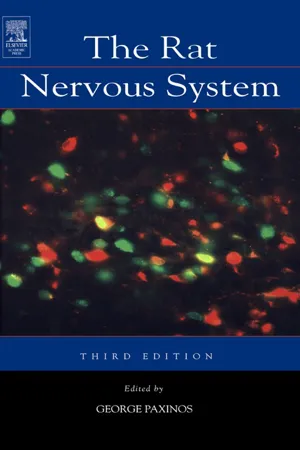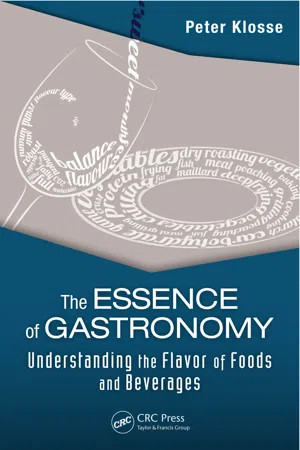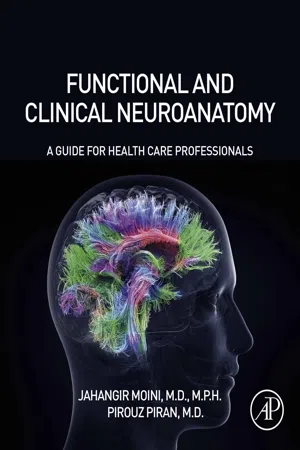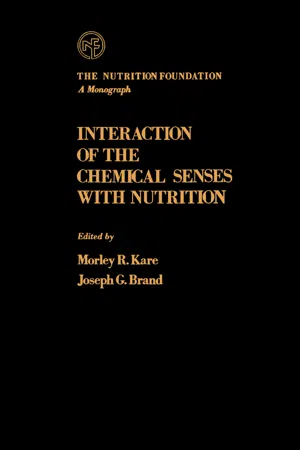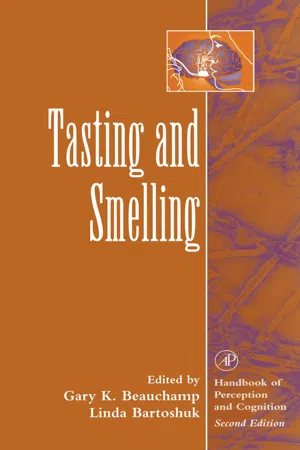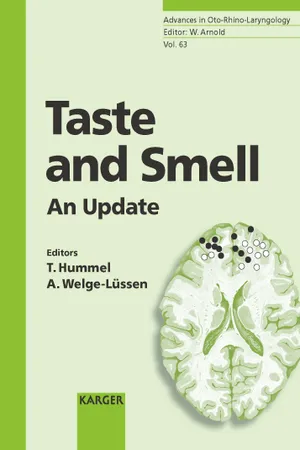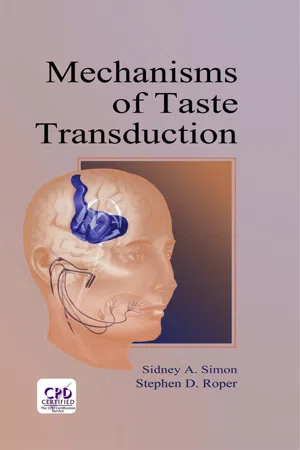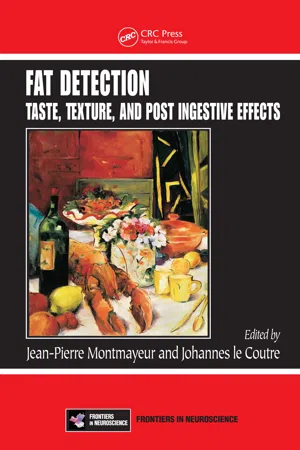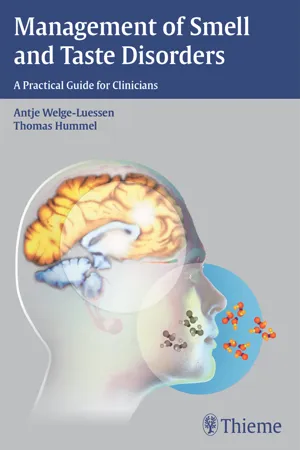Psychology
Gustatory System
The gustatory system refers to the sensory system responsible for the perception of taste. It involves the detection of chemicals in food and drink by taste receptors located on the tongue and in the mouth. These receptors send signals to the brain, allowing individuals to experience the sensations of sweet, sour, salty, bitter, and umami tastes.
Written by Perlego with AI-assistance
Related key terms
1 of 5
12 Key excerpts on "Gustatory System"
- eBook - ePub
- George Paxinos(Author)
- 2004(Publication Date)
- Academic Press(Publisher)
CHAPTER 28 Gustatory SystemRobert F. Lundy, JR., Ralph Norgren Department of Behavioral Science, College of Medicine The Pennsylvania State University Hershey, Pennsylvania, USAThe gustatory apparatus bridges the sensory systems that deal with the external world and those that report on the internal one. The receptors are located in the oral cavity, which brings food and fluids from outside of the body into the gastrointestinal tract. Taste buds work in concert with oral thermal and tactile receptors to evaluate these substances, but in the brain, gustatory afferent axons segregate more with the visceral than with the somatic sensory system. The central Gustatory System parallels the other visceral afferent systems that reach the brain over the cranial nerves but also maintains a close relationship to the central trigeminal nuclei. Due to its transitional location at the beginning of the alimentary canal, taste has several advantages over other visceral afferent modalities. The receptors are accessible and the adequate stimuli, easily specified. As with many external stimuli, humans can describe both the quality and intensity of sapid chemicals with considerable accuracy. As with many internal stimuli, humans also describe tastes in affective terms; they are either pleasant or aversive. Thus, on a number of dimensions, the Gustatory System spans the exteroceptive and interoceptive sensory domains (Sherrington, 1906 ). Because we know so much about the former and so little of the latter, within the brain at least, taste has served as a foil for the somatosensory systems, but as a guide to their visceral counterparts.C. J. Herrick (1931) classified taste as a special visceral afferent system and this chapter respects that conception by emphasizing what is distinctive about taste within the brain. Most of the features that are shared with the visceral and somatic afferent systems are cross-referenced to the chapters in this book that deal with those subjects (see Saper, Chapter 24 , and Waite, Chapter 27 - eBook - PDF
- David R Soderquist(Author)
- 2002(Publication Date)
- SAGE Publications, Inc(Publisher)
SENSORY PROCESSES Gustation Gustation s you eat your breakfast, you may have wondered about the taste of a new cereal or the sweetness of strawberry jam. The gustatory delights in which we all partake are the result of the chemical molecules and their inter-actions with olfactory and gustatory receptors. We have discussed the olfac-tory system in the previous chapter. Now we direct our attention to another chemical sense. This one, gustation, is considered to be a lesser sensation to humans. It is not, however, any less important to us than olfaction (McLauglin & Margolskee, 1994). It happens that when we have ageusia, which means to have no sense of taste, we quickly discover the importance of gustation. We can also discover the usefulness of taste by studying it. This chapter begins with an overview of the peripheral portion of the taste system. The periphery includes the oral cavity and the nerves that innervate the taste receptors. After we have examined these structures and functions, we expand our discussion to the more central portions of the nervous system and our cortex. The perception of taste and some of the dysfunctions of taste completes the chapter. We begin the discussion at the place you most expect, the oral cavity. Not only does the mouth provide us with a most useful orifice for communication, it also acts as the aperture through which our life’s sustenance must pass. This latter function is of maximum importance in maintaining our everyday exis-tence. There are, as we know, many substances we should not ingest. We must be careful of what we eat. An important function of the gustatory sense is to act as a sentry to screen and clear the way for our nourishment. Taste provides a very unambiguous warning. Those substances that have a bad taste should not be eaten. Just as with the olfactory sense, if a piece of meat has bad taste, it probably is bad. - eBook - PDF
The Essence of Gastronomy
Understanding the Flavor of Foods and Beverages
- Peter Klosse(Author)
- 2013(Publication Date)
- CRC Press(Publisher)
Traditionally, the gustatory part of tasting has received intensive scientific attention. Many reports are available on the so-called basic tastes, most of which rely on detailed studies often involving all sorts of animal species. However, it cannot be expected that flavor will be fully elucidated with a sole focus on one of the sensorial systems. Flavor perception is the outcome of a true synthesis of sensory registration. In this chapter, we will elaborate on the neural path-ways and remain largely at the registration level of papillae and other recep-tors of information. In Chapter 7, we move up into the brain, the electrical machine that processes all sensory information and informs and guides us. TASTING: WHAT HAPPENS IN THE MOUTH? When food is introduced into the mouth, the tongue positions and presses it against the palate. This gives textural information. The food is moistened by saliva, and a process of chewing and swallowing begins. This is the pro-cess of mastication, during which the food is fractured and deformed by a complex combination of compressing, shearing, and tensing. The tongue, cheeks, and lips play a major role by directing the food and making it ready to swallow. This process coincides with the release of tastants, odor-ants, and the assessment of all kinds of textural properties of the food. These concepts refer to the sensory system that registers the information. 24 THE ESSENCE OF GASTRONOMY © 2010 Taylor & Francis Group, LLC Tastants are substances that are transduced by the taste cells of the gusta-tory system, odorants are registered by the olfactory system, and irri-tants and textural elements are processed by the trigeminal system. Saliva plays an important role in this process. Secretion takes place in response to chewing and to certain flavor properties, such as pH. Saliva mixes with the food and acts as a lubricant. It also facilitates flavor perception. - eBook - ePub
Functional and Clinical Neuroanatomy
A Guide for Health Care Professionals
- Jahangir Moini, Pirouz Piran(Authors)
- 2020(Publication Date)
- Academic Press(Publisher)
electrogustometers that are used to measure taste intensity, and to determine detection and recognition thresholds of taste and olfactory stimuli. However, these are only used in extreme cases.Focus on the “umami” or “savory” sense of tasteThe Japanese term “umami” is equivalent to the English word “savory.” It has been recognized as the fifth basic taste, in addition to the better-known tastes of sweet, sour, bitter, and salty. Savory dishes evoke pleasant emotions, and this form of taste is a signal that a food source is rich in protein. The sensory cells specifically involved in this form of taste were originally discovered in Japan in 1910.Section review- 1. Where is the distribution of taste buds?
- 2. What are the physiological characteristics of taste buds?
- 3. What is the location of the gustatory centers within the brain?
Clinical considerations
There are many conditions of the limbic, olfactory, and Gustatory Systems that must be understood. Limbic system conditions include emotional disturbances, which may be due to hallucinations or pain, emotional lability, spasmodic (pseudobulbar) emotional disturbances, anger, violent behaviors, rage due to temporal lobe seizures, rage without seizures, violence due to neurologic diseases, aggressiveness due to encephalopathies and drug intoxication, apathy, placidity, alterations in sexuality, anxiety, euphoria, fear, and differential limbic diagnoses. Olfactory system conditions include anosmia, parosmia, hallucinations, and agnosia. Gustatory System conditions include ageusia, hypogeusia, and dysgeusia.Emotional disturbances of the limbic structures
Regarding the limbic system, there are a variety of neurological factors related to emotional disturbances. Illusions and hallucinations are classified as perceptual abnormalities, while delusions are classified as cognitive derangements. Emotional lability as well as pathologic laughing and crying, which is known as the pseudobulbar state - eBook - ePub
- Susan A. Lanham-New, Ian A. Macdonald, Helen M. Roche, Susan A. Lanham-New, Ian A. MacDonald, Helen M. Roche, Ian A. Macdonald, Susan A. Lanham-New, Ian A. MacDonald, Helen M. Roche(Authors)
- 2011(Publication Date)
- Wiley-Blackwell(Publisher)
All food enters the body through the mouth. From the time of birth, we select what is beneficial to eat and reject that which will cause ill-health. The food senses have evolved to aid this decision-making process. In our modern world, the protective role of sensation is primarily to detect spoiled or tainted foods, as few now roam the countryside hunting, gathering and sampling unusual ‘food’. However, we retain the psychological foundations upon which a ‘safe and nutritious’ diet from initially unknown foods is built, where we observe others, are encouraged to taste by information, sample by tasting and await the post-ingestion physiology consequences (without intention). This learning, often by association, results in a dietary habit of consuming foods with familiar sensory properties, but which may evolve slowly as we age. Within the range of palatable foods in the marketplace, subtle differences in taste, smell or texture can therefore have dramatic influence on individual preferences, ultimately determining quantity consumed, repeated intake and potential nutrition. Individual preferences are underpinned by genetics and determined by the impact of environment and experiences from early life.The food senses have independent physiology and will be considered separately in this chapter. However, during consumption, these distinct sensory modalities interact to determine palatability and few consumers make any distinction. In fact, palatability is determined by a combination of all sensations relevant to food acceptability, including taste, smell, warmth or cold, touch, texture, pain and even visual sensations. In this chapter it will therefore be necessary to consider the perception of the senses together, particularly with regard to the understanding of sensory preferences.9.2 The taste systemUnlike vision or olfaction, taste is a proximal sense, meaning that the primary stimulus for taste must make contact with the taste receptors, therefore the process of tasting begins in the oral cavity, primarily on the tongue. Taste receptors are stimulated by contact with liquid compounds, creating perceptions that endow distinctive taste qualities such as sweet, salty, sour, bitter and umami to these compounds.Anatomy and physiology of the taste systemTaste receptors, located primarily on the tongue and soft palate, are termed taste buds (Figure 9.1 - eBook - ePub
- Alexandru Grumezescu(Author)
- 2016(Publication Date)
- Academic Press(Publisher)
Section 1 , the authors discuss that human eating behavior is triggered not only by the physiological needs, but also learning and experiences developed through our daily life. From next section, the mechanisms and the phenomena of flavor perception are discussed based on this motivation theory.2. Physiological Aspects of Umami Taste Perception
When we eat a food, we experience a “taste” sensation. The term of “taste” sensation used in our daily life is different from that used in the aspects of psychology and physiology. The academic term for “taste sensation” is “gustation,” which is defined as the sensation caused by activation of taste cells in oral cavity and tongue. The tastants isolated from foods and beverages bind to the taste receptor and activate the taste cells. Based on the definition, there are five basic tastes in humans: sweet, salty, sour, bitter, and umami.The sensation occurring during eating foods is defined as a flavor perception. The flavor perception consists of several sensations, including gustation, olfaction, and somatosense in the oral cavity. During eating, we also feel (subliminally, in many cases) somatosense and visceral senses evoked in esophagus, stomach, intestine, and so on. In this section, the sensations evoked during eating are reviewed, mainly on umami sensation.2.1. Physiological Fundamentals Underlying the Feeling of Deliciousness
During meals, we can enjoy foods through simultaneously integrating huge amounts of information inputted from the five sensations (vision, audition, olfaction, gustation, and somatosenses). Among these sensations, people tend to pay more attention on gustatory sensation. Indeed, living organisms start and stop eating based on the gustatory sensation. They can detect the components in foods that are supplied by the gustatory cues. Regarding to physiological and safety needs, the organisms naturally intake sweet-taste foods, and avoid bitter-taste foods. - Morley Kare(Author)
- 2012(Publication Date)
- Academic Press(Publisher)
PART IV Interplay of Chemical Senses with Nutrient Metabolism This page intentionally left blank 16 Taste and the Autonomic Nervous System* RALPH NORGREN Department of Behavioral Science and The Milton S. Hershey Medical Center Pennsylvania State University Hershey, Pennsylvania I. Introduction 323 II. The Afferent Limb 325 III. The Efferent Limb 329 IV. The Central Projections 334 References 340 I. INTRODUCTION Gustatory afferent activity influences many aspects of feeding and drink-ing behavior. Psychophysics and electrophysiology attempt to understand how the gustatory apparatus codes and categories chemical stimuli, usually within the framework of human verbal descriptions of pure chemical stimuli. Perceived quality, however, represents only one dimension of the influence that taste exerts over energy and hydromineral balance (Norgren, 1984, 1985). Behavioral, endocrine, and autonomic responses to gustatory stimuli occur in chronically decerebrated rats, thus obviating the thalamocortical mechanisms that presumably underlie psychophysical assessments (Grill and Norgren, 1978a; Norgren and Grill, 1982). In addition, some of these re-sponses to taste stimuli appear to be organized on sensory dimensions that differ from the four standard qualities derived from human judgments. For instance, in rats oral glucose appears to be the major unconditioned stimulus *From Chemical Senses, Volume 10, No. 2, pp. 143-161. Reprinted by permission of IRL Press. 323 Interaction of the Chemical Senses with Nutrition 324 Ralph Norgren for the neurally mediated preabsorptive release of insulin, although glucose is less sweet to humans and less preferred by rodents than several other sugars (Grill et al, 1984). These observations serve only to emphasize that, as with other sensory systems, responses to gustatory afferent activity are organized at different levels of the nervous system, and perhaps on more than one sensory dimension.- eBook - PDF
- Gary K. Beauchamp, Linda Bartoshuk(Authors)
- 1997(Publication Date)
- Academic Press(Publisher)
Hopes of revealing uni= versal laws of tasting, reliance on physical rather than biological definitions of stimu- lus simplicity, and excessively facile movement between quite different levels of analysis have often led to parochial, contentious, and convoluted gustatory hy= potheses, and nonilluminating experiments. One possible solution is an open and nondogmatic approach to the complexity of the psychophysics of taste and of taste perception, with a constant albeit sometimes distant validity check provided by be- havioral responses to the beverages and foods that humans choose and consume or reject. Acknowledgments I thankJeannine F. Delwiche, Kathleen M. Dorries, Robert P. Erickson, Herbert U Meiselman, Thomas Neuhaus, Michael O'Mahony, and Susan S. Schiffman for critical comments on earlier drafts of this chapter. References American heritage electronic dictionary (1992). (Version 1.1, college/professional ed.). Novato, CA: WordStar International. American heritage electronic dictionary (1993). [CD-ROM] (Deluxe 3rd ed.). Novato, CA: StarPress. Amerine, M. A., Pangborn, R. M., & Roessler, E. B. (1965). Principles of sensory evaluation of food. New York: Academic Press. Andersen, H. T. (1970). Problems of taste specificity. In G. E. W. Wolstenholme & J. Knight (Eds.), Taste and smell in vertebrates (pp. 71-82). London: Churchill. Atkinson, R. C., Herrnstein, R.J., Lindzey, G., & Luce, R. D. (Eds.). (1988). Steven's handbook of experi- mental psychology: Vol. 1. Perception and motivation (2nd ed.), New York: Wiley. Ayya, N., & Lawless, H. T. (1992). Quantitative and qualitative evaluation ofhighqntensity sweeteners and sweetener mixtures. Chemical Senses, 17, 245-259. Backus, J. (1977). The acoustical foundations of music (2nd ed.). New York: Norton. Barlow, H. B., & Mollon, J. D. (Eds.) (1982). The senses. Cambridge: Cambridge Univ. Press. Bartoshuk, L. M. (1980). Sensory analysis of the taste of NaC1. In M. - eBook - PDF
Taste and Smell
An Update
- T. Hummel, A. Welge-Lüssen, Patrick J. Bradley(Authors)
- 2006(Publication Date)
- S. Karger(Publisher)
They are not. In rodents, diet has been shown to have a profound effect on gustatory organization [128–132], which may in turn be related to preferences [133]. Likewise in humans, diet has been shown to affect the pleasantness perception of taste qualities [134], and the importance of being able to adapt taste preferences to the food available in the environment has been emphasized [135]. The influence of diet upon taste pleasantness perception and preference suggests that although the relationship between the intrinsic affective value and quality is generally very stable, and possibly present at birth, learning can and does occur. This in turn implies that the intrinsic affective value and quality are separable at the neural level. Genetic differences may also contribute to differences in preferences and hence to the perceived pleasantness of a taste. Deviations in sweet preference have been associated with higher risk for drug abuse [136], and obesity [137–139]. Small 204 For example, Kampov-Polevoy et al. [140] reported increased liking of concen-trated sweet solutions in subjects with a family history of alcoholism. Neuro-physiological correlates of taste preference have not been examined in humans but the relationship with obesity and drug abuse suggests that preferences are related to differences in the underlying neural reward circuitry rather than being simply a result of diet. The affective value of a taste may also change as a result of conditioning, nutrient depletion, or internal state [93, 132, 133, 141–153], as well as by per-ceived intensity [1, 90–92], with the nature of the interaction depending upon quality. Taken together, these findings underscore the fact that gustatory hedon-ics are multifaceted, likely involve separate neural substrates and are dependent upon other perceptual dimensions. - eBook - PDF
- Sidney A. Simon, Stephen D. Roper(Authors)
- 2014(Publication Date)
- CRC Press(Publisher)
Chapter 5 THE DEVELOPING Gustatory System: FUNCTIONAL, MORPHOLOGICAL AND BEHAVIORAL PERSPECTIVES Robert E. Stewart and David L. Hill TABLE OF CONTENTS I. Introduction ...................................................... 128 II. Development of Peripheral Taste Function ....................... 128 A. Bitter Taste ............................................... 129 B. Sweet Taste .............................................. 130 C. Salt Taste ................................................. 133 III. Development of the Central Gustatory Pathway .................. 141 A. Functional Development. ................................. 142 l. Nucleus of the Solitary Tract (NST) .............. 142 2. Parabrachial Nuclei (PBN) ........................ 145 B. Anatomical Development.. ............................... 146 l. Nucleus of the Solitary Tract .... . ................ 146 2. Development of Projection Neurons to Parabrachial Nuclei ............................... 148 3. Parabrachial Nuclei Development ................. 148 IV. Behavioral Development of the Gustatory System ............... 149 A. Sweet Taste Development ................................ 149 B. Sour and Bitter Taste Development ....................... 150 C. Salt Taste Development in Rat ........................... 150 D. Salt Taste Development in Human ..... . ................. 152 V. Summary and Future Directions ................................. 153 Acknowledgments ....................................................... 154 References ............................................................... 154 G-8493-5341-61931$0.00 + s.so C 1993 by CRC Pras. Inc . 127 Development of Peripheral Taste System 129 garding the morphological development of the peripheral taste system (see Chapter 4 ), information regarding the functional development of the peripheral taste system is relatively limited. - eBook - PDF
Fat Detection
Taste, Texture, and Post Ingestive Effects
- Jean-Pierre Montmayeur, Johannes le Coutre(Authors)
- 2009(Publication Date)
- CRC Press(Publisher)
105 4 Role of the Gustatory System in Fatty Acid Detection in Rats David W. Pittman CONTENTS 4.1 Introduction ................................................................................................. 105 4.2 Innate Preference for Dietary Fat and Fatty Acids ..................................... 106 4.3 Fatty Acid Detection by Rats ...................................................................... 107 4.4 Gustatory Chemoreception of Fatty Acids .................................................. 114 4.5 Summary and Conclusions ......................................................................... 119 References .............................................................................................................. 120 4.1 INTRODUCTION The prevalence of obesity has provided a strong incentive to understand the motivation to consume high-fat foods. Taste palatability of high-fat food is cited as the primary influence in the over consumption of dietary fat (Drewnowski, 1997; Drewnowski and Greenwood, 1983; McCrory et al., 1999, 2000; Warwick and Schiffman, 1990) and there is a strong positive correlation between obesity and daily high-level intake of dietary fat (McCrory et al., 1999; Miller et al., 1990, 1994). Traditionally, the sensory perception of dietary fat during ingestion has been characterized in terms of textural and postingestive effects. Certainly, dietary fat contributes to the mouthfeel of food-stuffs and can act as a positive reinforcer through fatty acid receptors found in the digestive tract that stimulate pathways leading to the natural reward centers of the brain. - eBook - PDF
Management of Smell and Taste Disorders
A Practical Guide for Clinicians
- Antje Welge-Lüssen, Thomas Hummel(Authors)
- 2013(Publication Date)
- Thieme(Publisher)
5,6 Similar findings were reported in electro -gustometric studies. 7,8 In electrogustometry (elec -tric stimulation of small regions of the tongue) in healthy humans, electric thresholds are higher on the tongue edge than on the tongue tip. 8 This should be kept in mind when comparing gustatory results in healthy humans with those in patients with taste disorders. This chapter describes common clinical taste tests, including questionnaires mainly in Europe and Japan. Isolated taste disturbances are rare. Patient History In more than two-thirds of patients, a detailed patient history provides diagnostic evidence of disturbances of the olfactory and gustatory sys -tem. 9 In most cases, patients suffering from smell and taste loss have isolated smell disorders or a combined olfactory and gustatory impairment rather than an isolated taste disturbance. 10 Loss of smell presenting as taste loss, with normal find -ings on gustatory testing, is described as a “flavor disturbance.” 10 Taste and flavor are generally used as synonyms. Retronasal olfaction has a strong influence on flavor perception and supports the need for a standardized psychophysical taste and smell test, rather than relying on the patients’ symptoms alone. Additionally, patients with anos -mia have poorer sensitivity to all taste qualities than normosmics. 11 Another aspect that is important to consider is innervation of the Gustatory System. On both sides, different nerves (the chorda tympani for the ante -rior two-thirds of the tongue and the glossopha -ryngeal nerve for the posterior part of the tongue) provide a gustatory supply for the tongue; the petrosal nerve supplies the soft palate. 12 Somato -sensory supply is provided by the trigeminal nerve. Patients reporting numbness or tactile dys -geusia 13 of the tongue are often unaware whether the trigeminal or the Gustatory System is affected.
Index pages curate the most relevant extracts from our library of academic textbooks. They’ve been created using an in-house natural language model (NLM), each adding context and meaning to key research topics.
